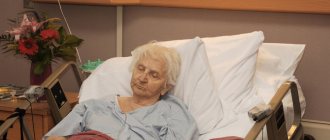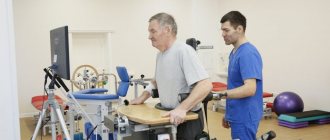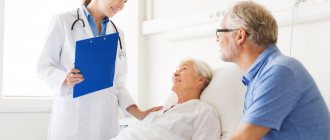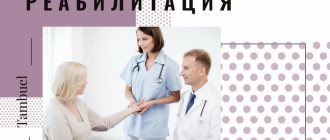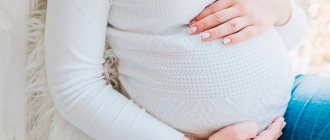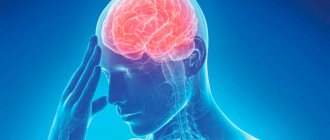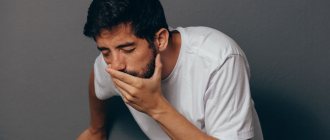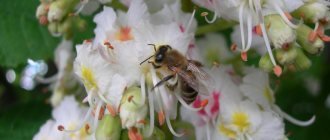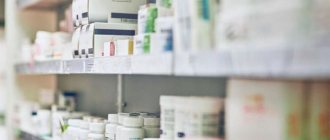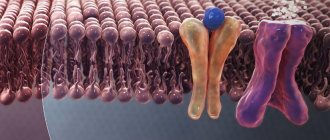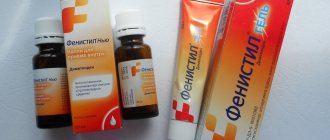10 minutes
A stroke is an acute disorder of cerebral circulation, leading to the destruction of brain tissue. Every year in Russia there are 450,000 cases of stroke - one every 1.5 minutes.
The causes of ischemic stroke can be atherosclerosis of cerebral vessels, coronary heart disease with cardiac arrhythmias, heart defects, osteochondrosis of the cervical spine, and arterial hypertension. With these diseases, obstruction or blockage of brain vessels develops, the blood supply to the brain is disrupted, which leads to bleeding of the brain - ischemia. If blood circulation in the ischemic area is not quickly restored, the brain tissue in it dies. The dead tissue then gradually dissolves to form cysts (holes) in the medulla.
The consequences of ischemic stroke are determined 90% by its severity and only 10% depend on treatment. Therefore, preventing stroke is many times more effective than treatment; Hippocrates said: “It is easier to prevent a disease than to treat it.”
Stroke prevention: simple rules for preventing stroke
Care after ischemic stroke
The patient should be in a bright, well-ventilated room, protected from extraneous noise, in which wet cleaning should be carried out regularly, at least 1-2 times a day.
The room should be ventilated several times a day so that the patient is not in a draft, and the average air temperature in the room is maintained at + 18-22 degrees.
Beds with sagging metal mesh cannot be used. It should be tightly stretched and covered with a dense mattress, for example foam rubber - the most hygienic and comfortable.
The caregiver is recommended to keep a diary in which to record indicators characterizing the patient: blood pressure, pulse, body temperature (it must be measured at least 3 times a day), the amount of fluid consumed (drinks, liquid dishes, fluid administered by infusion), the amount of excreted urine, frequency of bowel movements.
It is necessary to monitor the regularity of following the doctor's prescriptions.
To prevent congestion in the lungs, bedridden patients should do breathing exercises several times a day. The simplest type of breathing exercise is inflating a balloon.
In order to prevent bedsores, every 2-3 hours it is necessary to turn the patient over in bed, while performing a light massage of the skin on the back and sides of the chest, buttocks (stroking, rubbing). Special inflatable rings are placed under areas of the body where the risk of developing pressure sores is highest (heels, elbows, shoulder blades, buttocks, back of the head).
It is necessary to monitor the cleanliness of the patient's skin: regularly wash the patient's body with towels soaked in a weak soap solution, then wipe the skin dry. In some cases, camphor alcohol is used to cleanse the patient's skin.
After each meal, you need to clean your mouth of food debris.
Be sure to monitor the condition of the skin in natural folds (perineal area, groin and armpits, in women - under the mammary glands), as well as in fat folds. Areas of skin redness (maceration) should be treated with a gauze swab moistened with a pink solution of potassium permanganate or camphor alcohol.
If bedsores appear, you should consult a doctor about the rules of their treatment.
Characteristic symptoms
Clinical manifestations of extensive damage to brain tissue are always pronounced. If they appear, you should call an ambulance as quickly as possible, since the patient needs urgent hospitalization. His life depends on how quickly adequate treatment is started.
Characteristic symptoms:
- intense headache;
- dizziness;
- impaired coordination of movements;
- instability in a vertical position;
- loss of orientation in space;
- nausea and vomiting;
- hyperemia of the facial area;
- cold sweat;
- dry mouth;
- cardiopalmus;
- disorders of visual, auditory or olfactory perception;
- loss of consciousness;
- speech disorders (indistinct pronunciation of words and individual sounds);
- muscle spasms (cramps);
- paralysis and paresthesia of half the body;
- memory losses.
In cases where the victim is unconscious, it is advisable to conduct a pupillary test. One of the important signs of a stroke is the lack of reaction (constriction) of one pupil to a light stimulus.
Rehabilitation after ischemic stroke
Basic principles
1. Early start of the rehabilitation process - from the first hours of stroke development. At the very beginning, this is primarily:
Correct positioning of affected limbs
To prevent bedsores and the respiratory system, you should lie on both the healthy and paralyzed side. The healthy leg should be straightened, and the paralyzed leg should be brought forward slightly, slightly bent and placed on a pad. Place a pillow under the paralyzed arm.
To lie on the painful side, you should place a pillow under the patient's back to relax the muscles and stabilize him so that he does not roll out of bed. The paralyzed arm should be extended forward. Straighten your arm and place your palm up.
Attention: Do not lie on the paralyzed side for a long time.
The patient can lie with his head elevated for 15-30 minutes 3 times a day, starting from the first day of the disease.
Regularly changing the position of a post-stroke patient in bed
The position of the body in bed should be changed as often as possible. Prolonged pressure on the same areas of the body can lead to the formation of bedsores.
The patient’s position in bed should also be changed to improve bronchial function. If the patient is constantly in the same position, then sputum from some bronchi, under the influence of gravity, flows into the trachea and is coughed up, but from other bronchi, on the contrary, does not flow. And stagnation in any hollow organ leads to its inflammation. Even in the absence of dangerous microorganisms, microbes begin to multiply in the area of stagnation, which leads to pneumonia, which is difficult to cure in a weakened person. Frequent turns in bed help avoid this complication.
Massage
The massage procedure contributes to the overall health of the body, normalization of blood circulation in various parts of the patient’s body, restoration of lost functions or their compensation, normalization of muscle tone, increased joint mobility, elimination of trophic disorders in paralyzed limbs. The pathology of the connection between the muscles of a paralyzed limb and the nervous system leads not only to immobilization of the limb, but also to disruption of tissue nutrition.
Massage after a stroke
Therapeutic exercise (physical therapy)
Exercise therapy is a method of prevention using exercise, often combined with physical therapy and massage.
Exercises for recovery after a stroke
The sooner rehabilitation measures are started, the more lost functions will be restored or compensated.
2. Systematic long-term treatment over many months and sometimes years. Therapy (drug and non-drug) should continue in accordance with the recommendations of the attending physician.
3. Rehabilitation must be comprehensive. It is necessary to combine drug treatment with physical, psychological and speech therapy.
4. Consistency and phasing. At each stage, specific tasks should be set to restore lost functions. After completing the stage, the tasks change as your health improves.
5. Active participation of the patient and his family in the rehabilitation process.
Hyperbaric oxygenation
In diseases when the delivery of oxygen to organs and tissues is disrupted, including ischemic stroke, hypoxia develops - oxygen starvation. The brain is especially sensitive to a lack of oxygen and cannot function normally when it is deficient. In such situations, a modern treatment method, a type of oxygen therapy - hyperbaric oxygenation (HBOT), is used to improve oxygen supply.
Oxygen therapy: treatment and prevention of diseases
Hyperbaric oxygenation is a treatment method using pressure chambers in which the patient breathes an air mixture with an oxygen concentration 5 times higher than normal air. Due to the increased pressure and concentration, oxygen easily and quickly dissolves in the blood and is distributed throughout the body with its current. All tissues of the body are saturated with oxygen, even those in which blood circulation is impaired.
As a result, metabolic processes and blood circulation are improved, the neutralization and removal of waste and harmful substances from the body is accelerated, the functioning of all internal organs is normalized, the body's need for medicinal substances is reduced and their therapeutic effect is enhanced.
In addition, HBO has an anti-edematous effect, promotes the proliferation of blood vessels and restores blood supply to the affected areas of the brain.
Treatment can only be carried out after consultation with a doctor.
Physiotherapy
After a stroke, electromyostimulation, darsonvalization (electrotherapy), faradization (treatment using low-frequency alternating current in pulsed mode), balneotherapy (hydrotherapy), acupuncture, phototherapy and treatment with ionized air are prescribed.
Physiotherapy sessions are held at the Cardiological Sanatorium. The following medical services are also provided: hydrotherapy, inhalations, therapeutic massage, herbal medicine, exercise therapy and drug therapy.
Aromatherapy
The use of the following essential oils is recommended: oil of styrax benzoin, black pepper, eucalyptus, garlic, geranium, ginger, juniper, lemon, tangerine, rosemary, clary sage, thyme.
Oils are used for massage, as bath additives, and to scent the air.
Difference between left-sided and right-sided lesions
If extensive cerebral circulation disorder is located in the right hemisphere, the following are observed:
- left-sided paralysis;
- paralysis of facial muscles on the left side;
- passivity and general depressed state of the victim;
- memory impairment.
Important: In some cases, speech dysfunction is minor, which makes it difficult to make a correct diagnosis.
If the focus of the pathology is located in the left hemisphere, the following comes to the fore:
- right-sided paralysis;
- serious mental disorders;
- speech disorders;
- pronounced problems with logical thinking.
What exercises can you do?
Physical education classes begin with simple exercises. After successful completion, they move on to more complex ones. Healthy limbs need to be developed to increase support on them. A paralyzed arm or leg must “perform” passive flexion and extension until it “learns” to work more or less fully again.
You should start training in bed in a lying position
Feet recommended:
- climb up;
- bend and straighten your knees;
- twist your feet in both directions.
After about 2 weeks, you can perform the exercises while standing:
- walk slowly in place;
- lift the bent knee forward, move it to the side.
The squat is performed when the patient has fully restored the ability to stand upright and move around while maintaining balance.
Warming up the arms begins with flexion and extension of the elbows, hands, and fingers. To develop small movements with your fingers, you can use gaming techniques:
- mosaic,
- laying out cards,
- puzzles,
- fingering the rosary.
Hand movements are more finely organized by the brain, so recovery will require more effort
A patient after such a serious illness as a stroke must again learn to use a spoon and fork, or a door key. You should not pay attention to the methods of grasping an object; the patient himself chooses the most convenient option.
Some experts recommend tying a healthy arm to the body for five hours and trying to get by with one sore limb. This is necessary to create an emergency situation for the brain and force it to quickly return functions to the paralyzed arm.
Is it possible to use traditional medicine?
Folk remedies are not decisive in the recovery period. All medications are prescribed and discontinued by a doctor. Auxiliary traditional methods must be agreed with the doctor. They are used without limiting therapy and other recommendations.
You should not be fooled by advertisements that claim “the growth of new nerve cells.” This is a complete bluff. Scientists are indeed conducting experiments on the use of stem cells for patients with strokes, increasing the activity of the opposite hemisphere. And the effect of decoctions and herbal tinctures is based on lowering cholesterol and supporting the immune system.
These properties have:
- garlic-lemon tincture;
- various recipes from pine cones;
- onion ointment.
First aid
Irreversible changes in the brain begin within a few hours after the first signs of a major stroke appear. There is the concept of a “therapeutic window” - a period of 4.5 hours, during which it is still possible to prevent the death of a critical number of nerve cells. In practice, doctors have significantly less time to carry out a set of measures - on average, about one and a half hours.
If symptoms appear that indicate an acute circulatory disorder, you need to call a medical team without wasting a minute. Before their arrival, it is necessary to calm the victim and help him take a semi-lying or horizontal position with his head raised. If the patient is unconscious, the head should be turned to the side to prevent aspiration of vomit. The shirt collar should be unbuttoned, the trouser belt should be loosened, and other clothing that may restrict breathing should be removed. To ensure the flow of fresh air, it is recommended to open a window or vent.
If the attack began against the background of a hypertensive crisis, to improve the outflow of blood from the brain, you can lower the patient’s legs into a basin of hot water.
Important: It is strictly forbidden to give vasodilators, as well as give water and food to the patient! You should not take him to the hospital on your own, especially by public transport!
Relatives or friends need to accompany him to the hospital by ambulance, so that they can then describe the symptoms in detail to the doctors. This will help specialists objectively assess the situation and quickly make the correct diagnosis.
If necessary, the ambulance team can perform mechanical ventilation and tracheal intubation, as well as administer drugs to lower blood pressure and begin correcting the water and electrolyte balance by placing a drip with saline solution. The basic principle that guides transportation is “delivery with the least possible deterioration in condition.”
How to restore swallowing?
Patients themselves associate swallowing problems with sensitivity on only one side of the mouth, the lips. Therefore, they cannot fully swallow food, choking and coughing.
Training will help restore sensitivity to the required level by doing the following exercises:
- imitation of the swallowing process with an empty mouth;
- yawning, opening your mouth wide;
- gargling with plain water;
- coughing;
- the patient puffs out his cheeks and holds the condition for a few seconds;
- pronouncing the long sound “i” while simultaneously tapping the larynx with your fingers.
What to do in the period from three months to six months?
After 3 months of successful recovery, the patient adapts to his condition and moves independently with the help of a stick. After 6 months, he learns to climb steps and carry light bags. Goes shopping in the store, walks, uses transport.
It is necessary to equip the patient with a telephone with quick access and put a note in his pocket indicating personal information, address and contact telephone number of relatives. These measures will add confidence to the patient and reassure the family.
Physical exercises can be performed with light dumbbells, pedaling on a simulator
During this period, it is already possible to gain lost muscle mass.
If the training of the patient’s right hand does not allow writing, then attention should be paid to mastering this function with the left hand.
What to prepare for welcoming a patient from the hospital?
The conditions for home treatment of a patient with a stroke should first of all provide for his safety and ease of mastering movements.
The bathroom, toilet, and bedside area must have grab bars or other devices that allow the patient to sit down and stand up without assistance.
- You should remove unnecessary things, boxes, carpets, wires from home appliances from the paths of movement. They increase the risk of falling.
- Some patients lose their sense of temperature and can get burned by too hot water. This will require installing thermometers in the bathroom.
- At first, it is better to use a tray or a small portable table for the patient’s food; it will be difficult to be in a common kitchen or dining room.
The purchase of a wheelchair can be postponed for six months, when the prospects for rehabilitation measures become clear. During this period, the patient may begin to walk independently.
If watching television programs is of great interest to the victim, then he will need a remote switch.
